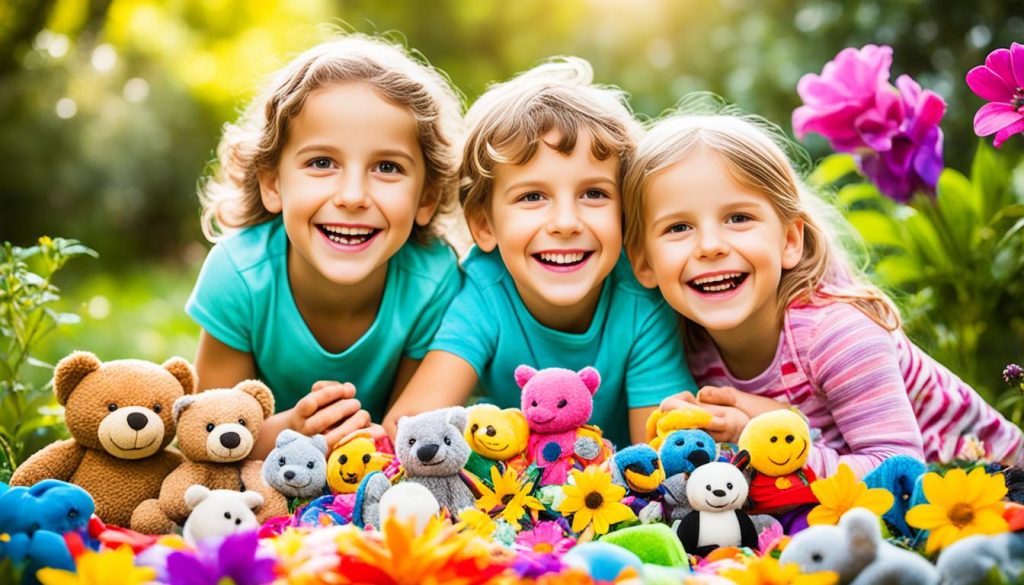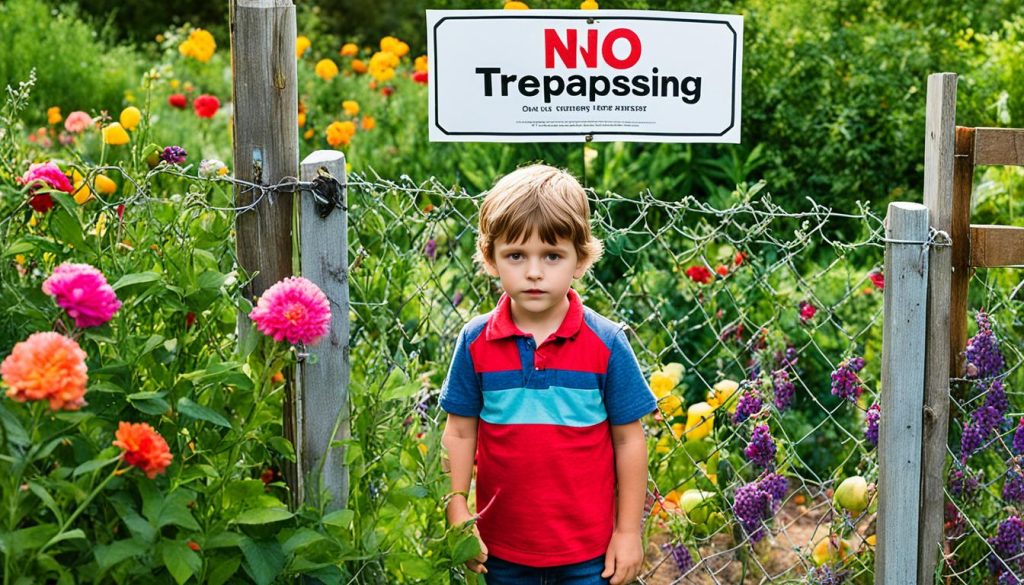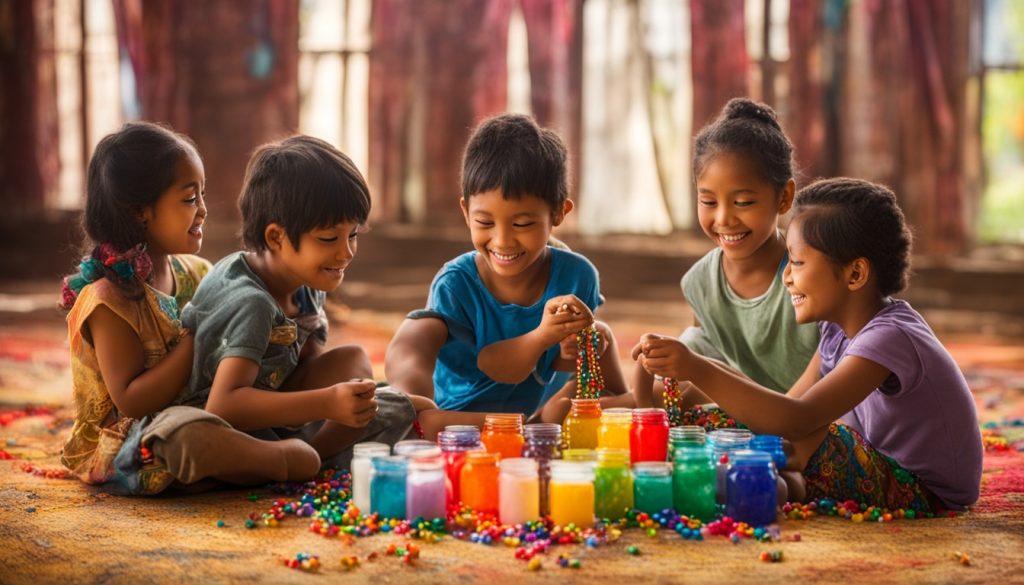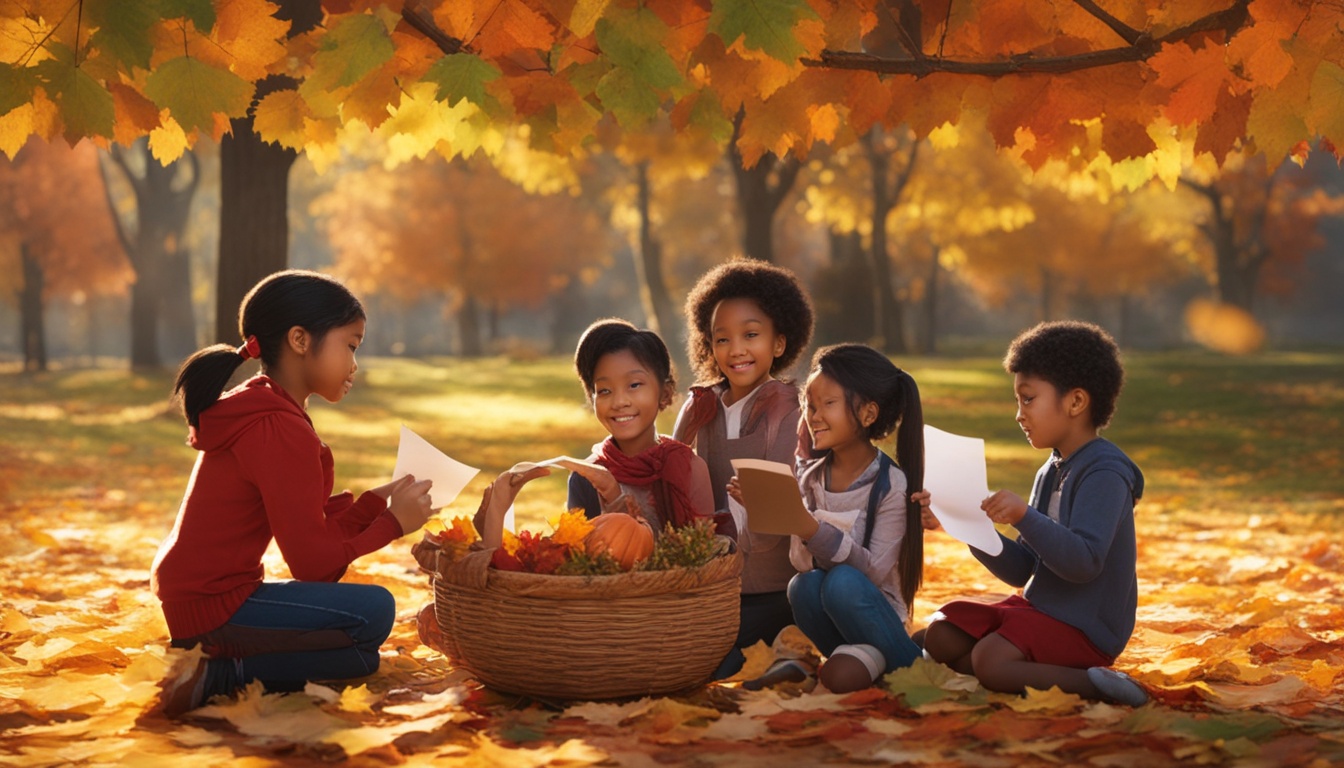Remember when a simple “thank you” made your day brighter? That warm feeling of being valued is something we want our kids to know. Teaching them about gratitude and generosity is more than just good manners. It’s about helping them feel empathy, happiness, and a deep thanks for life’s gifts.
As parents, we play many roles. We teach and model for our kids, shaping their values. Studies show that kids who are thankful tend to be happier and have better relationships. This makes us hopeful that the gratitude we teach now will help our kids later on.
Did you know 95% of parents think it’s key to teach kids to be thankful? This belief crosses cultures and ages. Ancient thinkers like Cicero saw gratitude as a top virtue, saying it’s the base of all virtues. This shows its big role in growing up right.
We can add simple, strong gratitude habits to our daily life. From saying thanks at bedtime to noticing kind acts, we can help our kids develop a deep “attitude of gratitude.” Let’s look at how we can make these lessons a big part of our parenting. This way, our kids will get the importance of being generous and thankful.
Key Takeaways
- Research shows that kids who are thankful are happier and have stronger relationships.
- A huge 95% of parents believe teaching gratitude is vital for their kids.
- Showing gratitude at home can help kids keep a thankful mindset for a long time.
- Fun activities like gratitude journals and projects can make learning about gratitude exciting.
- Teaching kids about gratitude and giving means showing them the value of small acts of kindness.
Understanding the Importance of Gratitude and Generosity
Teaching kids to be thankful early on can lead to a happier life later. By age 5, gratitude is linked to happiness and is key for social skills. Kids who are thankful feel more optimistic and satisfied with life, do better in school, and have more friends.
Keeping a gratitude journal helps kids see the good in life, even when things are tough. It’s not just about saying thanks. It also helps kids understand and manage their feelings better.

Being thankful can make kids feel less jealous, sad, and focused on stuff they don’t have. Saying thanks and talking about what we’re thankful for helps kids grow. Writing thank-you notes is a great way to teach kids to be grateful for a long time.
Family traditions, like saying thanks at Sunday dinner, help kids stay grateful. Kids in grateful homes value experiences and things more deeply. They show thanks for more than just gifts.
Outdoor play is also key for gratitude. It lets kids connect with nature and friends. This helps them feel thankful for the world around them.
Grateful people are healthier and happier. They bounce back better and feel better about themselves. Teaching kids to help others without being asked teaches them to be kind and thoughtful. It helps them grow into caring adults.
The Impact of Positive Parenting on Teaching Gratitude
Positive parenting deeply affects how children learn to be grateful. When parents show and practice gratitude, they set a good example for their kids. Studies show that kids of thankful parents are more appreciative and happier with their lives.

Role Modeling Behavior
Role modeling is key in teaching kids about gratitude through positive parenting. Parents can show thankfulness in daily life by saying “thank you” often. Writing thank-you notes and expressing gratitude can teach kids a lot. These actions help kids feel more grateful and can make them healthier, as gratitude is linked to better sleep and less stress.
Consistency and Patience
Being consistent and patient is important in parenting. Kids do better when parents are steady in their actions and patient. By always showing gratitude and encouraging kids to do the same, parents help build a thankful attitude. It’s also important to be flexible and accept different ways kids show gratitude. Finding the right balance helps keep kids interested in being thankful without overdoing it.
| Factor | Impact |
|---|---|
| Positive Parenting | Higher life satisfaction in children |
| Managing Screen Time | Improved emotional regulation and social interaction |
| Effective Discipline Strategies | Better appreciation and behavior in children |
Positive parenting is crucial in teaching kids about gratitude. It helps in many areas like emotions, health, and thinking. By being good role models, consistent, and patient, you can help your kids develop gratitude. This leads to a happier and healthier life for them.
Age-Appropriate Strategies for Different Developmental Milestones
It’s key to know about child development milestones to teach gratitude well. This part explains the best ways to teach gratitude to toddlers, preschoolers, and school-age kids.
Teaching Toddlers (Ages 2-3)
Toddlers start showing thanks with a little help. Since their early years are crucial, focusing on gratitude is important. Parents can help by saying thanks and doing small acts of kindness with their kids.

Engaging Preschoolers (Ages 3-5)
Preschoolers learn about gratitude by saying thanks and doing good deeds. At this age, it’s about setting rules and being creative. Encouraging them to make thank-you cards or help in the community boosts their creativity and empathy.
Encouraging School-Age Children (Ages 6-12)
School-age kids connect gratitude with feelings and appreciate helpers like firefighters or teachers. They can do more complex acts of thanks, like volunteering or writing letters. It’s still important to set rules to keep them responsible and independent.
| Developmental Stage | Age Range | Focus Areas |
|---|---|---|
| Infant | Birth to 18 months | Nurturing, Safe Exploration |
| Toddler | 2 to 3 years | Setting Boundaries, Simple Acts of Thanks |
| Preschooler | 3 to 5 years | Child Creativity, Charitable Activities |
| School-age Child | 6 to 12 years | Understanding Emotions, Community Appreciation |
Practical Activities to Foster Gratitude in Kids
Doing activities with kids can help teach them to be thankful. It also helps them understand the value of appreciation. These strategies can be part of daily life.
Gratitude Journals
Gratitude journals are great for kids to think about their day and what they’re thankful for. Writing down the good things helps them see the positives in their life. This can help with tantrums and boost their mental health. Writing before bed can make them sleep better and feel happier.
Family Gratitude Projects
Projects like making a gratitude board or jar bring everyone together. Each family member adds things they’re thankful for. It helps kids feel good about themselves and builds a grateful family bond.

Playing car games where you share what you like about each other can also teach gratitude. It’s a fun way for kids to say thanks and learn about appreciation.
| Activity | Benefit | Keyword |
|---|---|---|
| Gratitude Journals | Encourages daily reflection and positivity | Supporting Child Mental Health |
| Family Gratitude Projects | Enhances family bonding and shared appreciation | Building Self-Esteem in Children |
| Appreciation Car Games | Promotes verbal expression of thankfulness | Managing Child Tantrums |
Encouraging Kids to Express Gratitude
Teaching kids to say “thank you” is just the start. It’s about building a deep appreciation and strong connections with them. When kids think about why they’re thankful, they see their blessings and grow mentally.
Activities like the Gratitude Search help kids see the good in their lives. This makes them think about what they’re thankful for, helping their happiness and character grow.
A 21-Day Family Gratitude Challenge is a great idea. Families can share daily thanks for 21 days, showing how important gratitude is. Adding gratitude journaling lets kids write down what they appreciate each day, in their own way.
It’s important to always support their gratitude. Celebrate when they show thanks, big or small. Studies show that being thankful often makes people happier and more content.
Talking about gratitude at bedtime or dinner can make family bonds stronger. It teaches kids the value of being thankful every day.
Getting kids involved in helping others, like at shelters or soup kitchens, teaches them about community and caring. It also helps them find ways to say thanks, like writing cards or using a gratitude jar.
Adding gratitude to daily life helps kids learn to be thankful for a long time. Teach them to turn complaints into thanks and notice the amazing things in life. This builds a grateful family and helps kids stay mentally healthy and emotionally smart. By encouraging a growth mindset, you help them see the good in everything.
| Activity | Benefit |
|---|---|
| Gratitude Journals | Promotes reflection and daily appreciation |
| 21-Day Family Gratitude Challenge | Builds a sustained habit of expressing gratitude |
| Volunteer Work | Develops empathy and community sense |
| Thank You Cards | Encourages personal and direct expressions of thanks |
| Gratitude Jar | Visual and tangible way to recognize blessings |
The Role of Emotional Intelligence in Children
Teaching emotional intelligence early helps kids grow into caring and aware individuals. This skill is key for strengthening parent-child bonds and fostering child independence. It’s more important than IQ for success and happiness in life.
Empathy Development
Empathy starts with understanding and sharing others’ feelings. Parents play a big role in this by being emotionally aware. By teaching diversity to children, kids learn to see things from different viewpoints, building empathy.
- Establishing respect for emotions: Parents who respect their child’s feelings help boost emotional intelligence.
- Learning from mistakes: Encouraging kids to learn from mistakes helps them handle emotions better.
- Role modeling: Parents who are empathetic set a good example, leading to better mental health and relationships.
Recognizing and Naming Emotions
Knowing and naming emotions is vital for emotional smarts. It helps kids grasp their feelings and others’, crucial for gratitude and independence. Activities like emotion charades and daily talks help develop this skill.
- Emotion coaching: Teaching kids about emotions early, even at ten months, is beneficial.
- Acknowledging feelings: Accepting a child’s feelings helps build emotional intelligence without letting them manipulate you.
- Dynamic learning: Emotional smarts can be improved at any age, showing its importance in growth.
By improving emotional intelligence, parents make a supportive space. This helps kids become independent, caring, and open to diversity and feelings.
Conversations About Privilege and Compassion
Talking to your kids about privilege and compassion can really help them understand Family Respect and Empathy. Showing them how others have it harder than they do can make them more thankful and kind. Pragya Agarwal, a behavioral scientist, says kids start forming their views by age six. So, it’s key to talk to them early.
By nine, kids often have strong views that might be hard to change. So, it’s vital to keep talking about being kind and understanding. Doing community service together can show them how others live and help them feel for them. A 2020 UK survey found many kids aged eight to 16 worry about the planet, showing they care about the world.
Teaching kids to value their own spot in the world and the diversity around them is key. Getting them ready for kindergarten, where they’ll meet kids from different backgrounds, helps them be more caring and respectful. A supportive home environment is crucial for these important talks.
Talking about privilege and kindness helps kids understand Family Respect and Empathy. It’s important to make them see the value in their own life and situation. Open talks and doing things like community service make these ideas real and easy to grasp for kids.
Using Positive Reinforcement Parenting Techniques
Positive reinforcement parenting focuses on rewarding good actions, like saying thank you or sharing with others. This approach shows that getting a reward right after doing something good makes you more likely to do it again. Studies say a mix of 5 rewards for every correction helps kids be happier and grow well.
Praising Prosocial Behavior
When you praise kids for being kind, like sharing or helping, they want to keep doing it. Professor Carol Dweck says praising effort helps kids believe they can get better. Dr. John Gottman adds that showing love in how you talk to your child makes your bond stronger.
When kids act kindly, tell them you noticed and why it was great. This helps them feel they can make choices, do things well, and connect with others. It’s what positive discipline is all about.
Rewarding Acts of Kindness
There are many ways to reward kind actions. Young kids like stickers, while older kids might enjoy choosing activities. Praising them out loud or letting them pick what to do next makes them want to keep being kind.
Dr. Dan Siegel says showing interest in what your child likes helps build a strong bond. Praising good behavior quickly makes kids want to do more of it. This includes doing homework without complaining, getting along with siblings, and solving problems calmly.
Using positive reinforcement is a powerful way to change behavior. By praising kids for doing well and doing it right away, you create a supportive and kind home. This helps kids become more independent and teaches them the value of hard work, making your home more peaceful.
FAQ
How can I start teaching my kids about gratitude and generosity?
Why is it important for children to learn about gratitude?
How does positive parenting influence gratitude in children?
What are age-appropriate strategies to teach gratitude to kids at different developmental stages?
What are some practical activities to help kids cultivate gratitude?
How can I encourage my child to express gratitude?
How does emotional intelligence play a role in teaching gratitude?
How can conversations about privilege and compassion aid in fostering gratitude in children?
What positive reinforcement parenting techniques can I use to encourage gratitude?
This post contains affiliate links. If you click on a link and make a purchase, I may earn a small commission — at no extra cost to you. Thank you for supporting this blog and helping me keep the patterns free! Read the full Affiliate Disclosure & Transparency.
